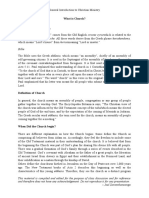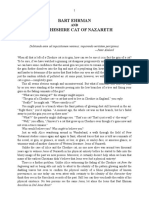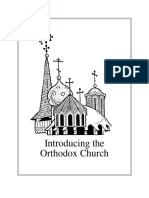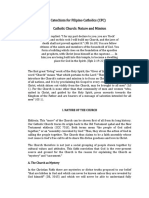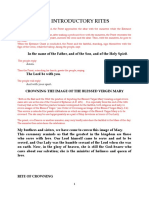I. Pre-Christian History of The Term: Reading: Church (ISBE Article)
I. Pre-Christian History of The Term: Reading: Church (ISBE Article)
Uploaded by
BenjaminFigueroaCopyright:
I. Pre-Christian History of The Term: Reading: Church (ISBE Article)
I. Pre-Christian History of The Term: Reading: Church (ISBE Article)
Uploaded by
BenjaminFigueroaOriginal Description:
Original Title
Copyright
Share this document
Did you find this document useful?
Is this content inappropriate?
Copyright:
I. Pre-Christian History of The Term: Reading: Church (ISBE Article)
I. Pre-Christian History of The Term: Reading: Church (ISBE Article)
Uploaded by
BenjaminFigueroaCopyright:
Reading: Church (ISBE Article)
The word "church," which is derived from κυριακός, kuriakós, "of or belonging to the Lord,"
represents in the English Versions of the Bible of the New Testament the Greek
word ἐκκλησία, ekklēsı́a; Latin, ecclesia. It is with the signification of this word ekklēsia as it
meets us in the New Testament, and with the nature of the society that the word is there used
to describe, that the present article is concerned.
I. Pre-Christian History of the Term
Although ekklēsia soon became a distinctively Christian word, it has its pre-Christian history;
and to those, whether Jews or Greeks, who first heard it applied to the Christian society it
would come with suggestions of familiar things. Throughout the Greek world and right down to
New Testament times (compare Acts 19:39), ekklēsia was the designation of the general
assembly of the whole body of citizens in a free city-state. They were "called out" (Greek ek,
"out," and kaleı́n, "to call") by the herald for the discussion and decision of public business. The
Septuagint translators, again, had used the word to render the Hebrew k ̣āhāl, which in the Old
Testament denotes the "congregation" or community of Israel, especially in its religious aspect
as the people of God. In this Old Testament sense, we find ekklēsia employed by Stephen in
the Book of Acts, where he describes Moses as "he that was in the church in the wilderness"
(Acts 7:38). The word thus came into Christian history with associations alike for the Greek and
the Jew. To the Greek, it would suggest a self-governing democratic society; to the Jew a
theocratic society whose members were the subjects of the Heavenly King. The pre-Christian
history of the word had a direct bearing on its Christian meaning. For the ekklēsia of the New
Testament is a "theocratic democracy" (Lindsay, Church and Ministry in the Early Centuries,
4), a society of those who are free, but are always conscious that their freedom springs from
obedience to their King.
II. Adoption by Jesus
According to Matthew 16:18, the name ekklēsia was first applied to the Christian society by
Jesus Himself, the occasion being that of His benediction of Peter at Caesarea Philippi. It is
true that Jesus had up to this time described the society He came to found as the "kingdom of
God" or the "kingdom of heaven," a designation that had its roots in Old Testament teaching
and which the Messianic expectations of Israel had already made familiar. But now when it was
clear that He was to be rejected by the Jewish people (compare Matthew 16:21), and that His
society must move on independent lines of its own, it was natural that He should employ a new
name for this new body which He was about to create. So the "kingdom" terminology grew into
the understanding of "ecclesia", that is the church. Thus, Jesus said to Peter, on the ground of
the apostle's believing confession, "Upon this rock I will build my church." The adoption of this
name, however, did not imply any abandonment of the ideas suggested by the conception of
the kingdom.
III. Use in the New Testament
1. In the Gospels
Apart from the passage just referred to, the word ekklēsia occurs in the Gospels on one other
occasion only in Matthew 18:17. Here it may be questioned whether our Lord is referring to the
Christian church, or to Jewish congregations commonly known as synagogues. The latter view
is more in keeping with the situation, but the promise immediately given to the disciples of
power to bind and loose in Matthew 18:18 and the assurance "Where two or three are
gathered together in my name, there am I in the midst of them" (Matthew 18:20) are evidently
meant for the people of Christ. If, as is probable, the ekklesia of Matthew 18:17 is the
Christian ekklesia of which Christ had already spoken to Peter, the words show that He
conceived of the church as a society possessing powers of self-government, in which
questions of discipline were to be decided by the collective judgment of the members.
2. In Acts
In Acts, the ekklēsia has come to be the general designation for the society of Christian
believers but is employed in two distinct senses. First, in a local sense, to denote the body of
Christians in a particular place or district, as in Jerusalem (Acts 5:11; Acts 8:1), in Antioch (Acts
13:1; Acts 15:22), or in Caesarea (Acts 18:22) - a usage which reappears in the Apocalypse in
the letters to the seven churches. Then in a wider and what may be called a universal sense, to
denote the total of existing local churches (Acts 9:31), which form one body.
3. In the Pauline Epistles
In the Pauline Epistles both of these usages are frequent. Thus, the apostle writes to "the
church of the Thessalonians" (1 Thessalonians 1:1), "the church of God which is at Corinth" (1
Corinthians 1:2; 2 Corinthians 2:1). Indeed, he localizes the word yet further by applying it to a
single Christian household or to little groups of believers who were accustomed to assemble in
private houses for worship and fellowship (Romans 16:5; 1 Corinthians 16:19; Colossians 4:15;
Philippians 1:2). This use of the word recalls the saying of Jesus in Matthew 18:20.
The universal use, again, may be illustrated by the contrast he draws between Jews and
Greeks on the one hand and the church of God on the other (1 Corinthians 10:32). It can also
be seen in the declaration that God has set in the church apostles, prophets, and teachers (1
Corinthians 12:28).
But Paul in his later epistles has another use of ekklēsia peculiar to himself, which may be
described as the ideal use. The church, now, is the body of which Christ is the head
(Ephesians 1:22,23; Colossians 1:18,24). It is the vehicle through which God's wisdom and
eternal purpose are to be made known, not only to all men but also to the principalities and
powers in the heavenly places (Ephesians 3:9-11). It is the bride of whom He is the heavenly
Bridegroom. It is the bride for whom in His love He gave Himself up, that He might cleanse and
sanctify her and might present her to Himself a glorious church, a church without blemish, not
having spot or wrinkle or any such thing (Ephesians 5:25-27). This church clearly is not the
current church as we know it on earth, with its divisions, its blemishes, its shortcomings in faith
and love and obedience. It is the holy church that is to be when the Bridegroom has fully
"cleansed it by the washing of water through the word." It is the ideal that the current
church must keep before it and strive after. The ideal up to which it shall finally be guided by
that Divine in-working power that can conform the body to the head to make the bride worthy of
the Bridegroom so that God may receive in the church the glory that is His (Ephesians 3:21).
IV. Features of the Church
1. Full of Faith
There are certain characteristics of the Christian church that the New Testament gives us from
which we can form some conception as to its nature. A fundamental feature is faith. It was to
Peter confessing his faith in Christ that the promise came, "Upon this rock I will build my
church" (Matthew 16:18). Primarily the church is a society of believers. Hence, we find that
"believers" or "they that believed" is constantly used as a synonym for the members of the
Christian church (e.g. Acts 2:44; Acts 4:32; Acts 5:14; 1 Timothy 4:12). This church-founding
and church-building faith, of which baptism was the seal, was much more than an act of
intellectual assent. It was a personal laying hold of the personal Saviour, the bond of a vital
union between Christ and the believer which resulted in nothing less than a new creation
(Romans 6:4; Romans 8:1,2; 2 Corinthians 5:17).
2. Fellowship of Believers
If faith in Christ is the fundamental note of the Christian church, the next is fellowship
among the members. This feature follows from the very nature of faith as just described; for if
each believer is vitally joined to Christ, all believers must stand in a living relation to one
another. In Paul's favorite figure, Christians are members one of another because they are
members in particular of the body of Christ (Romans 12:5; 1 Corinthians 12:27). That the
Christian church was recognized from the first as a fellowship appears from the name "the
brethren," which is commonly applied to those who belong to it. In Acts, the name is of very
frequent occurrence (Acts 9:30, etc.), and it is employed by Paul in the epistles of every period
of his career (1 Thessalonians 4:10, etc.). Similar testimony lies in the fact that "the koinōnia"
("fellowship") takes its place in the earliest meetings of the church side by side with the
apostles' teaching and the breaking of bread and prayers (Acts 2:42). The koinōnia at first
carried with it a community of goods (Acts 2:44; Acts 4:32), and afterward found expression in
the fellowship of service to the saints (2 Corinthians 8:4), and In acts of Christian charity that
are inspired by Christian faith (Hebrews 13:16). In the Lord's Supper, the other sacrament of
the church, the fellowship of Christians received its most striking and most sacred expression.
For if baptism was especially the sacrament of faith, the Supper was distinctively the
sacrament of love and fellowship - a communion in Christ's death and its fruits that carried with
it a communion of hearts and spirits between the participants themselves.
3. Unity of the Body
Although local congregations sprang up wherever the gospel was preached, and each of these
enjoyed an independent life of its own, the unity of the church was clearly recognized from the
first. The desire for unity can be seen in the discussions between Jerusalem and Antioch (Acts
11:22; Acts 15:2), the conference held in the former city (Acts 15:6), the right hand of
fellowship given by the elder apostles to Paul and Barnabas (Galatians 2:9), the untiring efforts
made by Paul himself to forge strong links of love and mutual service between Gentile and
Jewish Christians (2 Corinthians 8). These things serve to show that though there were many
churches, there was but one church. This truth comes to its complete expression in the epistles
of Paul's imprisonment, with their vision of the church as a body of which Christ is the head, a
body animated by one Spirit, and having one Lord, one faith, one baptism, one God and Father
of all (Ephesians 4:4; Colossians 1:18; Colossians 3:11). And this unity, it is to be noticed, is
conceived of as a visible unity. Jesus Himself evidently conceived it so when He prayed for His
disciples that they all might be one so that the world might believe (John 17:21). And the unity
of which Paul writes and for which he strove is a unity that finds visible expression through the
manifestation of a common faith in acts of mutual love (Ephesians 4:3,13; 2 Corinthians 9:1-
15).
4. Consecration of the Saints
Another dominant note of the New Testament church lay in the consecration of the members.
Saints is one of the most frequently recurring designations for them that we find. As Thus
employed, the word has in the first place an objective meaning; the sainthood of the Christian
church consisted in its separation from the world by God's electing grace. In this respect, it has
succeeded to the prerogatives of Israel under the old covenant. The members of the church, as
Peter said, are "an elect race, a royal priesthood, a holy nation, a people for God's possession"
(1 Peter 2:9). But side by side with this sense of an outward and priestly consecration, the
"saints" practiced holiness - a holiness consisting, not merely in a status determined by relation
to Christ, but in an actual and practical saintliness, a consecration to God that finds expression
in character and conduct. No doubt the members of the church are called saints even when the
living evidence of sainthood are sadly lacking. Writing to the Corinthian church in which he
found so much to blame, Paul addresses its members by this title (1 Corinthians 1:2; compare
1 Corinthians 6:11). But he does so for other than formal reasons - not only because
consecration to God is their outward calling and status as believers; but also because he is
assured that a work of real sanctification is going on, and must continue to go on, in their
bodies and their spirits which are Christ's. For those who are in Christ are a new creation (2
Corinthians 5:17). And those to whom has come the separating and consecrating call (2
Corinthians 6:17) must cleanse themselves from all filthiness of the flesh and spirit, perfecting
holiness in the fear of God (2 Corinthians 7:1). Paul looks upon the members of the church,
just as he looks upon the church itself, with a prophetic eye; he sees them not as they are, but
as they are to be. And in his view, it is "by the washing of water with the word," in other words
by the progressive sanctification of its members, that the church itself is to be sanctified and
cleansed. This cleansing is done so Christ can present it to Himself a glorious church, not
having spot or wrinkle or any such thing (Ephesians 5:26,27).
5. Power in the Spirit
Another feature of the church was spiritual power. When the name ekklēsia was given by
Jesus to His followers, His promise to Peter for the church included the bestowal of the gift of
power (Matthew 16:18,19). The church was to receive the "power of the keys," to open the
doors of the kingdom of heaven to the Jew (Acts 2:41) and the Gentile (Acts 10:34-38; Acts
15:7). The church was further to have the power of binding and loosing, i.e. of forbidding and
permitting. The legislative powers bestowed upon Peter and the disciples (Matthew 18:18;
compare Matthew 18:1 and also Matthew 18:19,20), were at the conference in Jerusalem
exercised by the church as a whole (Acts 15:4,22). The power to open the gates of the
kingdom of heaven was expanded into the great missionary commission, "Go ye therefore, and
make disciples of all the nations" (Matthew 28:19). This command was a commission that was
understood by the apostolic church to be addressed not to the eleven apostles only, but to all
Christ's followers without distinction (Acts 8:4, etc.). To the Christian believers there belonged
the dual power of legislating for its members and of opening the kingdom of heaven to all
believers. But these dual functions of teaching and government were clearly recognized as
delegated gifts. The church taught the nations because Christ had bid her go and do it. She
laid down laws for her members because He had conferred upon her authority to bind and to
loose. But in every exercise of her authority she relied upon Him from whom she derived it.
She believed that Christ was with her always, even to the end of the age (Matthew 28:20) and
that the power she was given was from on high (Luke 24:49).
V. Organization of the Church
It seems evident from the New Testament that Jesus gave His disciples no formal prescriptions
for the organization of the church. In the first days after Pentecost, they did not realize the need
of any distinct organization of their own. The worship at the temple was still adhered to (Acts
2:46; Acts 3:1), though it was supplemented by apostolic teaching, by prayer and fellowship,
and by the breaking of bread (Acts 2:42,46). Organization was a thing of gradual growth
suggested by emerging needs, and the differentiation of function among those who were drawn
into the service of the church was due to the difference in the gifts bestowed by God upon the
church members (1 Corinthians 12:28). At first the Twelve themselves, as the immediate
companions of Jesus throughout His ministry and the prime witnesses of the Christian facts
and especially of the resurrection (compare Acts 1:21,22), were the natural leaders and
teachers of the community. Apart from this, the earliest evidence of anything like organization
is found in the distinction drawn by the Twelve themselves between the ministry of the word
and the ministry of tables (Acts 6:2,4). This distinction was fully recognized by Paul (Romans
12:6,8; 1 Corinthians 1:17; 1 Corinthians 9:14; 1 Corinthians 12:28) though he enlarged the
latter type of ministry so as to include much more than the care of the poor. The two kinds of
ministry, as they meet us at the first, may broadly be distinguished as the general and
prophetic on the one hand, the local and practical on the other.
1. The General and Prophetic Ministry
From Acts 6:1, we see that the Twelve recognized that they were Divinely called as apostles to
proclaim the gospel. Paul repeatedly makes the same claim for himself (1 Corinthians 1:17; 1
Corinthians 9:16; 2 Corinthians 3:6; 2 Corinthians 4:1; Colossians 1:1). But apostleship was by
no means confined to the Twelve (Acts 14:14; Romans 16:7). And an itinerant ministry of the
word was exercised in differing ways by prophets, evangelists, and teachers, as well as by
apostles (1 Corinthians 12:28,29; Ephesians 4:11). The fact that Paul himself is described as
an apostle, a prophet, a teacher (Acts 13:1; Acts 14:14; 1 Timothy 2:7; 2 Timothy 1:11)
appears to show that the prophetic ministry was not a ministry of stated office, but one of
special gifts and functions. The apostle carried the good tidings of salvation to the ignorant and
unbelieving (Galatians 2:7,8), the prophet (in the more precise sense of the word) was a
messenger to the church (1 Corinthians 14:4,22). And while the teacher explained and applied
truth that was already possessed (Hebrews 5:12), the prophet was recognized by those who
had spiritual discernment (1 Corinthians 2:15; 1 Corinthians 14:29; 1 John 4:1) as the Divinely
employed messenger of revelations (1 Corinthians 14:24,30,31; Ephesians 3:5).
2. The Local and Practical Ministry
The earliest examples of this are the Seven of Jerusalem who were entrusted with the care of
the "daily ministration" (Acts 6:1). With the growth of the church, however, other needs arose,
and the local ministry is seen developing in two distinct directions. First there is the presbyter
or elder, otherwise known as the bishop or overseer, whose duties, while still local, are chiefly
of a spiritual kind (Acts 20:17,28,35; 1 Timothy 3:2,5; James 5:14; 1 Peter 5:2). Next there are
the deacon and the deaconess (Philippians 1:1; 1 Timothy 3:8-13), whose work appears to
have lain chiefly in house to house visitation and a practical ministry to the poor and needy (1
Timothy 5:8-11). The necessities of government, of discipline, and of regular and stated
instruction had brought it to pass that within New Testament times some of the functions of the
general ministry of apostles and prophets were discharged by a local ministry. The general
ministry, however, was still recognized to be the higher of the two. Paul addresses the
presbyter-bishops of Ephesus in a tone of lofty spiritual authority (Acts 20:17-38).
Literature
Hort,The Christian Ecclesia; Lindsay, The Church and the Ministry in the Early Cents., lectsI-V;
Hatch,Bampton Lectures; Gwatkin, Early Church History to AD 313; Köstlin, article "Kirche" in
See Hauck-Herzog, Realencyklopadie fur protestantische Theologie und Kirche; Armitage
Robinson, article "Church" in Encyclopedia Biblica; Fairbairn, Christ in Modern Theology, 513-
34; Dargan, Ecclesiology; Denney, Studies in Theology, Ch viii.
Reading: John (ISBE Article)
John
The sources for the life of the apostle John are of various kinds, and of different degrees of
trustworthiness. There are the references in the Synoptic Gospels, which may be used simply and
easily without any critical preliminary inquiry into their worth as sources. For these Gospels contain
the common tradition of the early church and are accepted as trustworthy. Further, there are the
statements in Acts and in Galatians, which we may use without discussion as a source for the life
of John. There is next the tradition of the 2nd century, which we may use if we can show that
the John of Ephesus, who bulks so largely in the Christian literature of the 2nd and 3rd centuries, is
identical with the son of Zebedee. Further, on the supposition that the son of Zebedee is the author
of the Johannine writings of the New Testament, there is another source of unequaled value for the
estimate of the life and character of the son of Zebedee in these writings. Finally, there is the
considerable volume of tradition that gathered around the name of John of Ephesus, of which,
picturesque and interesting though the traditions are, only sparing use can be made.
I. A Witness of the New Testament.
Addressing ourselves first to the Synoptic Gospels, to Acts, and Galatians, we ask, what, from
these sources, can we know of the apostle John? A glance only need be taken at the Johannine
writings, more fully discussed elsewhere concerning their author.
1. The Synoptic Gospels:
That John was one of the two sons of Zebedee, that he became one of the disciples of Jesus, that
when Jesus called he forsook all and followed Jesus, and was after that continuously with Jesus to
the end, are facts familiar to every reader of the Synoptic Gospels. The call was given to John and
his brother James at the Sea of Galilee, while in a boat with their father Zebedee, "mending their
nets" (Matthew 4:21,22, and parallel passages). "Come, follow me," said Jesus, "and I will make
you fishers of men" (Mark 1:17). That Zebedee was a man of considerable wealth may be inferred
from the fact that he had "hired servants" with him (Mark 1:20), and that his wife was one of those
women who ministered of their substance to Jesus and His disciples (Matthew 27:55,56). The name
of John appears in all the lists of the apostles given in the Synoptic Gospels (Matthew 10:2 and
parallels).
While his name rarely appears in a position by itself, he is still one of the most prominent of the
disciples. With Peter and James, he is present at the raising of the daughter of Jairus (Mark 5:37;
Luke 8:51-56). These three were also present at the transfiguration (Matthew 17; Mark 9; Luke 9).
They were nearest to the Lord at the agony of Gethsemane. In all these cases, nothing
characteristic of John is to be noted. He is simply present as one of the three, and, therefore, one of
the most intimate of the disciples. But there is something characteristic in an incident recorded by
Luke (Luke 9:54), in which James and John are represented as wishing to call down fire on a
Samaritan village, which had refused them hospitality. From this can be inferred something of the
earnestness, zeal, and enthusiasm of the brothers, and of their high sense of what was due to their
Master.
Peter, James, John, and Andrew are the four who asked Jesus about the prophecies He had
uttered: "Tell us, when shall these things be? And what shall be the sign when these things are all
about to be accomplished?" (Mark 13:4). Then there is the request of their mother as to the place
she desired for her sons in the coming kingdom (Mark 10:35-45). To Peter and John was entrusted
the task of preparation for the keeping of the Passover (Luke 22:8). Once John stands alone and
asks what we may consider a characteristic question: "Teacher, we saw one casting out demons in
thy name; and we forbade him because he followed not us" (Mark 9:38; Luke 9:49). From these
notices we see that John was in the front rank of the disciples, and we see also that he was so far
conscious of the position he held, and of the intimate connection he had with the Master.
We note further that John was a young man of fiery zeal, and of a tendency toward intolerance and
exclusiveness. The zeal and the intolerance are in evidence in the desire to call down fire upon the
Samaritan village, and the tendency toward exclusiveness is manifested in the request of his
mother as to the place her sons were to occupy in the kingdom. They desire to have the highest
positions. These tendencies were not encouraged by Jesus. They were rebuked by Him once and
again. In harmony with these notices of character and temperament is the name given to the
brothers by Jesus, "Boanerges," "Sons of thunder" (Mark 3:17), which, whatever else may be meant
by it, means strength, unexpectedness, and zeal approaching methods of violence.
2. Acts and Galatians:
John is found in company with Peter in the opening scenes in Acts. He is with Peter while the man
at the gate was healed (Acts 3). He is with Peter on the mission to Samaria (Acts 8:14-25). He is
with Peter and James, the Lord's brother, at the interview with Paul recorded in Galatians 2, and the
three are described by Paul as the pillar apostles (Galatians 2:9). This discussion proves
that John had survived his brother James, whose death is recorded in Acts 12.
3. The Johannine Writings: Gospel and Revelation:
Much is to be learned of the Apostle John from the Fourth Gospel written by him. We learn from it
that he was a disciple of John the Baptist (John 1:35) and that he was one of the first six disciples
called by Jesus in His early ministry in Judea (John 1:37-51). We also learn that he was present at
all the scenes which he describes in the Gospel. We find later that he had a home in Jerusalem and
was acquainted with many there. To that home, he took Mary, the mother of Jesus, whom the dying
Saviour entrusted to his care (John 19:26,27). Much more also we learn of him and his history, for
the Gospel is a spiritual biography, a record of the growth of faith on the part of the writer, and of the
way in which his eyes were opened to see the glory of the Lord until faith seems to have become
vision. He was in the inner circle of the disciples; indeed, nearest of all to Jesus, "the disciple whom
Jesus loved" (John 13:23; John19:26; John 20:2; John 21:7,20), and, because of that love, became
the apostle of love.
The Book of Revelation, ascribed to John, bears important witness to the apostle's banishment in
later life to the Isle of Patmos in the Aegean (John 1:9). There he received the visions recorded in
the book. The banishment probably took place in the reign of Domitian, with whose practice it was
entirely in consonance. The testimony is of high importance in its bearing on the disputed question
of John's residence in Asia, a point now to be discussed.
II. The Ephesian Traditions.
1. John the Apostle, and John the Presbyter:
Thus, the early traditions of the churches are available for the life of John, the son of Zebedee. But
there remain many blank spaces in that life. After the reference to the pillar apostles in Galatians,
silence falls on the life of John, and we know nothing of his life and activity until we read of his
banishment to Patmos, and meet with those references to the old man at Ephesus, which occur in
the Christian literature of the 2nd century. One point of interest relates to the (genuine) quotation
from Papias, preserved by Eusebius (Historia Ecclesiastica, III, 39), regarding a "Presbyter John," a
disciple of the Lord, who was one of his living authorities. Were there two Johns at Ephesus? Or
was there only one? Or, if there was only one, was he John the Evangelist, or only John the
Presbyter? Here there is every possible variety of opinion. Many hold that there were two, and
many that there was only one. Many who hold that there was only one, hold that the one
was John the son of Zebedee; others hold, with equal assurance, that he was a distinct person.
Obviously, it is impossible to discuss the question adequately here. After due consideration, we lean
to the conclusion that there was only one John at Ephesus, and he was the son of Zebedee. For the
proof of this, impossible within our limits, we refer to the learned argument of John Chapman, in his
work John the Presbyter and the Fourth Gospel (1911).
2. Characteristic Traditions:
Into the traditions that cluster round John in Ephesus it is not necessary to enter in detail (compare
Godet, op. cit., 57 ff). According to the tradition universally accepted in the church, John survived
until the time of Trajan (98 AD). Striking and characteristic things are told of him in harmony with the
touches we find in the Synoptic Gospels. The story of his rushing forth from the bath when
Cerinthus, the heretic, entered it (Irenaeus, Adv. Haer., iii. 3,4) recalls the characteristics of him
whom Jesus called "son of thunder." The same tone of exclusiveness, modified by larger
experience, is found in the 1st Epistle, which so frequently and so decisively discriminates between
those who believe in Jesus and those who do not.
III. The Character of John.
The general character of this great apostle is already sufficiently apparent. We recall the illustrative
facts found in the Synoptics: that James and John were the two who wished to call down fire from
heaven on the inhospitable village, that John was one of those who desired one of the chief places
in the kingdom, that he forbade the man to cast out demons in the name of Jesus because he
followed not with them. We do not forget that on each of these occasions he was corrected and
rebuked by the Master, and he was not the kind of man who could not profit by the rebuke of Jesus.
So that vehemence of disposition was held in check, and, while still in existence, was under control,
and allowed to have vent only on occasions when it was permissible, and even necessary. So in his
writings, and in the reflections in the Gospel, we note the vehemence displayed but now directed
only against those who refused to believe in, and to acknowledge, Jesus.
"A quiet and thoughtful temperament is by no means inconsistent with a certain vehemence, when,
on occasions, the pent-up fire flashes forth; indeed, the very violence of feeling may help to foster a
habitual quietude, lest word or deed should betray too deep an emotion. Then it is not without
significance that, in the three narratives that are cited from the Gospels to prove the overbearing
temper of John, we are expressly told that Jesus corrected him. Are we to suppose that these
rebukes made no impression? Is it not more likely that they sank deep into his heart, and that the
agony of beholding his Master's crucifixion made them ineffaceable? Then, if not before, began that
long development which changed the youthful son of thunder into the aged apostle of love"
(Drummond, op. cit, 410,411).
But love itself has its side of vehemence, and the intensity of love toward a person or a cause may
be measured by the intensity of aversion and hatred toward their contradictories. There are many
reflections in the Gospel and in the Epistles that display this energy of hatred toward the work of the
devil, and toward those dispositions that are under the influence of the father of lies. We notice
these, for they prove that the fervent youth devoted to his Master carried with him to the end the
same disposition that was characteristic of him from the beginning
You might also like
- Orthodox Dogmatic Theology FR Michael Pomazansky PDFDocument236 pagesOrthodox Dogmatic Theology FR Michael Pomazansky PDFAndrei Lupse100% (4)
- Theology Simplified by Bob YandianDocument79 pagesTheology Simplified by Bob YandianEMMANUEL OSAFO BOAKYENo ratings yet
- Buddhism Through Christian Eyes SmithDocument64 pagesBuddhism Through Christian Eyes SmithCamadNo ratings yet
- The Way by Fr. George MetallinosDocument137 pagesThe Way by Fr. George Metallinosdelef375% (4)
- What Is ChurchDocument3 pagesWhat Is ChurchAnkam Manideep75% (4)
- Serve Him With MirthDocument75 pagesServe Him With Mirthanhbq1706No ratings yet
- Instructed EucharistDocument7 pagesInstructed EucharistBenita CastellanoNo ratings yet
- Which Is The True Church Or, A Few Plain Reasons For Joining The Roman Catholic Communion, Charles F. B. Allnat PDFDocument72 pagesWhich Is The True Church Or, A Few Plain Reasons For Joining The Roman Catholic Communion, Charles F. B. Allnat PDFJuan MarinNo ratings yet
- Bart Ehrman - Did Jesus Exist (Critics1)Document18 pagesBart Ehrman - Did Jesus Exist (Critics1)lacisag100% (1)
- Taize Song LyricsDocument1 pageTaize Song LyricsKram Sales100% (1)
- Priniples of Church GrowthDocument47 pagesPriniples of Church Growthfrecousminzee5No ratings yet
- Definitons of Church and Relation To ParachurchDocument11 pagesDefinitons of Church and Relation To ParachurchAnne Lavallee SpanNo ratings yet
- The Concept of The Church in Christianity: K. Shekhar (PH.D)Document4 pagesThe Concept of The Church in Christianity: K. Shekhar (PH.D)j100% (1)
- McBrien - What Is The ChurchDocument5 pagesMcBrien - What Is The ChurchAtasha Adrienne GarciaNo ratings yet
- ECCLESIOLOGYDocument11 pagesECCLESIOLOGYjosh7ebaNo ratings yet
- Lesson 15Document7 pagesLesson 15henryNo ratings yet
- Ecclesiology RDocument21 pagesEcclesiology RTesfaye NokoNo ratings yet
- The Church Presents How The First ChristianDocument198 pagesThe Church Presents How The First ChristianCharmaine LumenNo ratings yet
- Webinar 1 PDFDocument46 pagesWebinar 1 PDFJatricc Qhyzer RodriguezNo ratings yet
- Course. CRS120Document2 pagesCourse. CRS120Olufunsho PaulNo ratings yet
- Nature of The ChurchDocument9 pagesNature of The ChurchSemiti KotoNo ratings yet
- Ecclesiastical Metaphors: Here We Present Two Paper On The ChurchDocument3 pagesEcclesiastical Metaphors: Here We Present Two Paper On The ChurchEverything newNo ratings yet
- Pneumatological EcclesiologyDocument9 pagesPneumatological EcclesiologyHanny SetiawanNo ratings yet
- A Theological Understanding of The Nature of The ChurchDocument17 pagesA Theological Understanding of The Nature of The ChurchChandra Sekar100% (1)
- Fr. George Metallinos - The Way An Introduction To The Orthodox FaithDocument114 pagesFr. George Metallinos - The Way An Introduction To The Orthodox FaithJustino Carneiro100% (4)
- Broadbent W G The Doctrine of FellowshipDocument47 pagesBroadbent W G The Doctrine of FellowshipVijilan Parayil VijayanNo ratings yet
- The ChurchDocument48 pagesThe ChurchIsh Selin0% (1)
- Javier Del Angel - SE - Q2Document6 pagesJavier Del Angel - SE - Q2javierxaireNo ratings yet
- Re 103 LessonDocument3 pagesRe 103 LessonAmbray Felyn JoyNo ratings yet
- Essential Characteristics of The ChurchDocument9 pagesEssential Characteristics of The ChurchJoenetha Ann Aparici100% (1)
- 1970 SS 07-01-04Document52 pages1970 SS 07-01-04Rizaldy FerrerNo ratings yet
- Catholicism,,, Fundamentals of The Catholic ChurchDocument20 pagesCatholicism,,, Fundamentals of The Catholic ChurchScribdTranslationsNo ratings yet
- Biblicial Theology 4Document16 pagesBiblicial Theology 4Barikpe Honyto100% (1)
- The Church and Its Ministry.: t88 Cheltenham Conference PapersDocument7 pagesThe Church and Its Ministry.: t88 Cheltenham Conference PapersswaroopdokiburraNo ratings yet
- Christian Way of Life Topic 1Document3 pagesChristian Way of Life Topic 1Danielyn GestopaNo ratings yet
- Module III - Nature of The ChurchDocument7 pagesModule III - Nature of The ChurchJaybelle Faith ManticahonNo ratings yet
- Definitions of Church Bibl MissiologyDocument8 pagesDefinitions of Church Bibl MissiologyAnne Lavallee SpanNo ratings yet
- Church As BodyDocument26 pagesChurch As BodyAnonymous D83RFJj34No ratings yet
- Orthodox Dogmatic TheologyDocument201 pagesOrthodox Dogmatic TheologyThom Crowe100% (1)
- Re103-2 Reviewer Module 1 and 2Document16 pagesRe103-2 Reviewer Module 1 and 2Nightcore - FR BlastNo ratings yet
- ChurchDocument16 pagesChurchat.villaflorNo ratings yet
- Four Marks of The ChurchDocument3 pagesFour Marks of The ChurchDieudonne SongNo ratings yet
- Biblical Refl. On CathDocument75 pagesBiblical Refl. On CathAnselm JimohNo ratings yet
- Founder of The Church - HagiographyDocument7 pagesFounder of The Church - HagiographyFrancis GonzagaNo ratings yet
- Lumen Gentium PDFDocument29 pagesLumen Gentium PDFsilviya60scsNo ratings yet
- Introducing The Orthodox ChurchDocument13 pagesIntroducing The Orthodox Churchfabian100% (1)
- The Beginning of The New Chosen People of God: Lesson 1Document14 pagesThe Beginning of The New Chosen People of God: Lesson 1Honda Rs 125No ratings yet
- Dogmatics PomazanskyDocument197 pagesDogmatics Pomazanskycab186No ratings yet
- The Church of Christ Possesses The Inseparable Unity of The Human and Divine Elements (LG 8) - The Church of Christ Which Is BothDocument25 pagesThe Church of Christ Possesses The Inseparable Unity of The Human and Divine Elements (LG 8) - The Church of Christ Which Is BothTrisha MariehNo ratings yet
- Andy Woods Kingdom9Document6 pagesAndy Woods Kingdom9Chandra SekarNo ratings yet
- Sr. Maria Falentina Wea, MSBS: ScripturesDocument3 pagesSr. Maria Falentina Wea, MSBS: Scripturesfalentina weaNo ratings yet
- Nature of The ChurchDocument15 pagesNature of The ChurchKelly AlairNo ratings yet
- BT ChurchDocument50 pagesBT ChurchGladston CunhaNo ratings yet
- Pillar of FireDocument14 pagesPillar of FirerobbinmitchellNo ratings yet
- Lecture 2 (Misconceptions About The Church)Document5 pagesLecture 2 (Misconceptions About The Church)Reegan SamsonNo ratings yet
- St. Louis College of Bulanao: Purok 6, Bulanao, Tabuk City, Kalinga 3800Document3 pagesSt. Louis College of Bulanao: Purok 6, Bulanao, Tabuk City, Kalinga 3800Albina AwinganNo ratings yet
- The Epiclesis For Reformed Eucharistic PrayerDocument26 pagesThe Epiclesis For Reformed Eucharistic PrayerBogdan Stefan AvramNo ratings yet
- Orthodox Dogmatic TheologyDocument210 pagesOrthodox Dogmatic TheologyDavid BorgNo ratings yet
- The Church As Sacrament Revisited: Sign and Source of Encounter With ChristDocument13 pagesThe Church As Sacrament Revisited: Sign and Source of Encounter With ChristEllenxevelyn100% (1)
- Lecture 1 (What Is The Church)Document5 pagesLecture 1 (What Is The Church)Reegan SamsonNo ratings yet
- Persia - India - China - Peru - Mesoamerica - Mediterranean BasinDocument153 pagesPersia - India - China - Peru - Mesoamerica - Mediterranean BasinBenjaminFigueroaNo ratings yet
- Christian Leader's Institute: World History 101 The Beginnings of "Civilization" To 1500 A.DDocument97 pagesChristian Leader's Institute: World History 101 The Beginnings of "Civilization" To 1500 A.DBenjaminFigueroaNo ratings yet
- 1Document162 pages1BenjaminFigueroaNo ratings yet
- 6Document108 pages6BenjaminFigueroaNo ratings yet
- Learning Styles 2Document21 pagesLearning Styles 2BenjaminFigueroaNo ratings yet
- Christian Leader's Institute: World History 101 The Beginnings of "Civilization" To 1500 A.DDocument54 pagesChristian Leader's Institute: World History 101 The Beginnings of "Civilization" To 1500 A.DBenjaminFigueroaNo ratings yet
- Roman Government in RepublicDocument75 pagesRoman Government in RepublicBenjaminFigueroaNo ratings yet
- Reading: Introduction To The Ancient Greeks: Meyers-Briggs Keirsey DDLI) (2Document12 pagesReading: Introduction To The Ancient Greeks: Meyers-Briggs Keirsey DDLI) (2BenjaminFigueroaNo ratings yet
- Reading: Introduction To Ontology: The Nature of BeingDocument13 pagesReading: Introduction To Ontology: The Nature of BeingBenjaminFigueroaNo ratings yet
- Silk Road: Joshua J. MarkDocument27 pagesSilk Road: Joshua J. MarkBenjaminFigueroaNo ratings yet
- Reading: The Philosophical ArgumentDocument10 pagesReading: The Philosophical ArgumentBenjaminFigueroaNo ratings yet
- Philosophy, Science Features Interviews With Seven Philosophy Ph.D.s Who HaveDocument12 pagesPhilosophy, Science Features Interviews With Seven Philosophy Ph.D.s Who HaveBenjaminFigueroaNo ratings yet
- 2Document71 pages2BenjaminFigueroaNo ratings yet
- 12Document48 pages12BenjaminFigueroaNo ratings yet
- Søren Kierkegaard (1813-1855) : Reading: An Introduction To Soren KierkegaardDocument8 pagesSøren Kierkegaard (1813-1855) : Reading: An Introduction To Soren KierkegaardBenjaminFigueroaNo ratings yet
- Reading: Introduction To The Question: Article 1: The Only GodDocument10 pagesReading: Introduction To The Question: Article 1: The Only GodBenjaminFigueroaNo ratings yet
- Holy Roman EmpireDocument58 pagesHoly Roman EmpireBenjaminFigueroaNo ratings yet
- John The Baptist I. SourcesDocument15 pagesJohn The Baptist I. SourcesBenjaminFigueroaNo ratings yet
- Reading: Introduction To Epistemology: Mind - N - 3307500.htmlDocument14 pagesReading: Introduction To Epistemology: Mind - N - 3307500.htmlBenjaminFigueroaNo ratings yet
- Reading: Hades, Sheol and Gehenna (ISBE Article)Document7 pagesReading: Hades, Sheol and Gehenna (ISBE Article)BenjaminFigueroaNo ratings yet
- Reading: Persecution (ISBE Article)Document19 pagesReading: Persecution (ISBE Article)BenjaminFigueroaNo ratings yet
- Reading: Synagogue (ISBE Article)Document10 pagesReading: Synagogue (ISBE Article)BenjaminFigueroaNo ratings yet
- Jerusalem: Reading: Jerusalem (ISBE Article)Document18 pagesJerusalem: Reading: Jerusalem (ISBE Article)BenjaminFigueroaNo ratings yet
- The Holy SpritDocument11 pagesThe Holy SpritBenjaminFigueroaNo ratings yet
- Jesus in TalmudDocument27 pagesJesus in TalmudIsc100% (2)
- Prayer of Release From The Stronghold of The Baphomet Freemasonry The Occult The New Age Sexual Sin Rape Etc.Document6 pagesPrayer of Release From The Stronghold of The Baphomet Freemasonry The Occult The New Age Sexual Sin Rape Etc.mazzagra100% (2)
- Overcoming Anxiety and Fear SOM17Document4 pagesOvercoming Anxiety and Fear SOM17Andree MeridaNo ratings yet
- Prophecies For The Philippines by IFPDocument16 pagesProphecies For The Philippines by IFPJuly Lyn L. DizonNo ratings yet
- How Did The Cat Eat The Grubbing Hoe Sermon and Outline by Charles A. YawnDocument3 pagesHow Did The Cat Eat The Grubbing Hoe Sermon and Outline by Charles A. YawnCharles A. YawnNo ratings yet
- (Downsub - Com) God Hates A Coward - The Greatest Motivational VideoDocument3 pages(Downsub - Com) God Hates A Coward - The Greatest Motivational VideoarcangelNo ratings yet
- Immigrants and The BibleDocument4 pagesImmigrants and The BibleAnonymous IsMgHVy9CONo ratings yet
- Secret CombinationsDocument100 pagesSecret CombinationsCory James Christensenn100% (2)
- Short Missionary BioDocument1 pageShort Missionary BioJeremy BlanzNo ratings yet
- The Secret of True BelieversDocument6 pagesThe Secret of True BelieversDr Jacquelyn PY SooNo ratings yet
- What Does The Bible Say About Social Media Sites Like Facebook, Twitter, Instagram, Path or Line?Document7 pagesWhat Does The Bible Say About Social Media Sites Like Facebook, Twitter, Instagram, Path or Line?Pepita SariNo ratings yet
- Beholding Advent Devotional 2Document56 pagesBeholding Advent Devotional 2Katie Esther LundbergNo ratings yet
- CCC, No. 1131 Ibid, No. 1996 Richard P. Mcbrien, Catholicism 3 Ed. Geoffrey Chapman A Continuum Imprint, London, P. 795 1Document9 pagesCCC, No. 1131 Ibid, No. 1996 Richard P. Mcbrien, Catholicism 3 Ed. Geoffrey Chapman A Continuum Imprint, London, P. 795 1Sal-clemNo ratings yet
- Genesis Part 2 Lesson 1-Kay ArthurDocument8 pagesGenesis Part 2 Lesson 1-Kay Arthurjavier100% (1)
- The Introductory Rites: AmenDocument21 pagesThe Introductory Rites: AmenfmeranaNo ratings yet
- Paul's Argument From Experience - Gal 3.1-5Document5 pagesPaul's Argument From Experience - Gal 3.1-531songofjoyNo ratings yet
- High Praise (Worship Prophetic Warfare) : Gilbert Hughes, MINISTER of The WordDocument9 pagesHigh Praise (Worship Prophetic Warfare) : Gilbert Hughes, MINISTER of The WordUbacus AlphonseNo ratings yet
- Religious Education Revision MaterialDocument64 pagesReligious Education Revision Materialtyrellbotha917No ratings yet
- Lyrics and Translations of SongsDocument6 pagesLyrics and Translations of SongsbaryodilonNo ratings yet
- John 109-113 (Verse-By-Verse Analysis)Document5 pagesJohn 109-113 (Verse-By-Verse Analysis)tryon gabrielNo ratings yet
- Reckless LoveDocument10 pagesReckless LoveJaidaly Andreina Avila MedinaNo ratings yet
- God's Problem by Bart D. Ehrman NotesDocument27 pagesGod's Problem by Bart D. Ehrman NotesHaiden Morgan80% (5)
- Herget James Carol 1985 HaitiDocument44 pagesHerget James Carol 1985 Haitithe missions networkNo ratings yet




